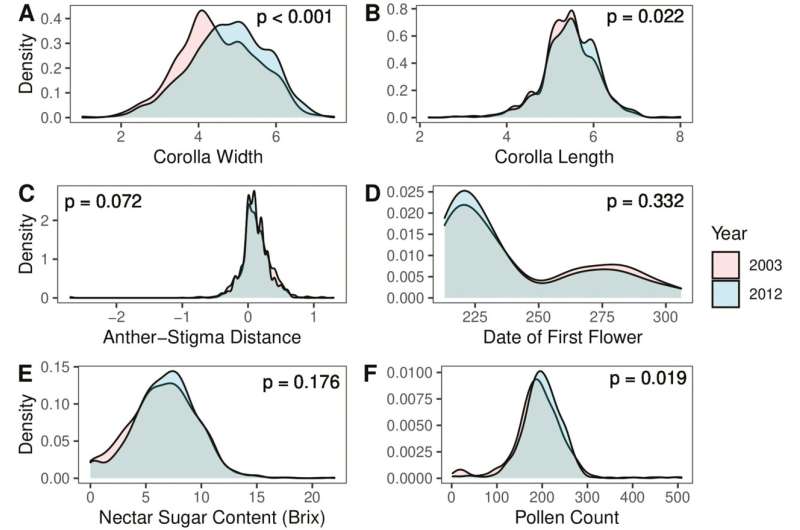This article has been reviewed according to Science X's editorial process and policies. Editors have highlighted the following attributes while ensuring the content's credibility:
fact-checked
peer-reviewed publication
trusted source
proofread
Bigger flowers, greater rewards: Plants adapt to climate disruptions to lure pollinators

There's been a well-documented shift toward earlier springtime flowering in many plants as the world warms. The trend alarms biologists because it has the potential to disrupt carefully choreographed interactions between plants and the creatures—butterflies, bees, birds, bats and others—that pollinate them.
But much less attention has been paid to changes in other floral traits, such as flower size, that can also affect plant-pollinator interactions, at a time when many insect pollinators are in global decline.
In a study published online in the journal Evolution Letters, two University of Michigan biologists and a University of Georgia colleague show that wild populations of the common morning glory in the southeastern United States increased the size of their flowers between 2003 and 2012.
Increased flower size suggests a greater investment by the plants in pollinator attraction, according to the researchers. The changes were most pronounced at more northern latitudes, in line with a broad range of previous work showing that northern plant populations tend to show more dramatic evolutionary responses to climate change.
A shift to earlier flowering was also observed among those morning glory populations. In addition, there were tantalizing indications that the plants have increased their investment in floral rewards—the nectar and pollen obtained by the bees, syrphid flies and wasps that pollinate the white, pink and blue morning glory flowers.
"There is a major gap in our understanding of how traits that are crucial for plant-pollinator interactions may be evolving over time as a response to a changing climate," said study lead author Sasha Bishop, a doctoral student in the U-M Department of Ecology and Evolutionary Biology.
"We show that—in addition to well-documented shifts to earlier flowering—floral architecture and rewards can also play significant roles in the evolutionary response to contemporary environmental change."
The common morning glory is an annual weedy vine found across the eastern, midwestern and southern United States. It is frequently seen along roadsides and crop fields.
The U-M-led study used a "resurrection" approach that involved germinating morning glory seeds collected from the edges of agricultural soy and corn fields in Tennessee, North Carolina and South Carolina in two years: 2003 and 2012.
During that nine-year span, the region experienced rising temperatures—particularly rising minimum and nighttime temperatures—and an increase in the number of extreme rainfall events interspersed with more extreme drought.
To look for changes in floral morphology, the researchers planted field-collected seeds from both years in a greenhouse at U-M's Matthaei Botanical Gardens. When the flowers bloomed, various floral traits were measured with digital calipers.
Measurements showed that morning glory corollas became significantly wider during the nine-year interval—4.5 centimeters (1.8 inches) in diameter in 2003 and 4.8 centimeters (1.9 inches) in 2012, and the change in corolla width was greatest in populations at more northern latitudes. The petals of a flower are collectively known as the corolla.
The study also revealed a shift to earlier flowering times between 2003 and 2012, driven primarily by populations at more northern latitudes. The start of flowering occurred an average of four days earlier for the plants grown from seeds collected in 2012.
Interestingly, the researchers also observed a latitude-influenced trend toward greater investment in floral rewards (pollen and nectar) over time. On average, morning glory flowers grown from 2012-collected seeds produced more pollen grains and more nectar sucrose than the flowers from the 2003-collected seeds.
However, the pollen and nectar analyses involved only four populations of morning glory plants. Due to the low number of populations examined, the floral rewards findings were not included in a statistical test to look for evidence that adaptation through natural selection is occurring in the plants.
"Nonetheless, it appears likely that there is a temporal increase in investment in pollinator attraction and that this result is driven by populations at northern latitudes," said study senior author Regina Baucom, an associate professor in the U-M Department of Ecology and Evolutionary Biology.
The study found no evidence that morning glories are increasing the rate at which they self-pollinate. Evidence from some previous studies pointed to increased "selfing" as a possible response to climate change and/or pollinator declines associated with land-use change.
"This is the first article to use the resurrection approach to examine the potential that traits responsible for plant-pollinator interactions may be evolving over time, concomitant to decreases in pollinator abundance and dramatic environmental changes due to changing climate and land-use regimes," Bishop said.
Fifteen morning glory populations were included in the resurrection experiment looking at changes in floral morphology. Twenty-three populations were included in the study of earlier springtime flowering. In total, 2,836 flowers were measured from 456 plants.
More information: Sasha G D Bishop et al, Not just flowering time: a resurrection approach shows floral attraction traits are changing over time, Evolution Letters (2023). DOI: 10.1093/evlett/qrad006
Journal information: Evolution Letters
Provided by University of Michigan


















